Oct 10-15: Sustainable Building Workshop
The Sustainable Buildings workshop through the Algonquin Tea Company was exactly what I was looking for- I can say for certain that it changed my life. Most people at the workshop were young twentysomethings at transition times in their lives, trying to figure out how to live a sustainable lifestyle: sound familiar? If they're anything like me, what they took from the workshop was not just invaluable specific information about everything from earthships to strawbale houses to biodiesel generation to forest foraging, but a push in the 'right' direction toward a healthier, more holistic, life. Here's a brief look at some of the things we learned:
Earthship - An earthship is a building that takes into account various sustainable building techniques such as passive solar design, thermal mass heating, using discarded 'waste' for wall construction (typically tires), rainwater capture, and more. We visited the home of Lisa and Erol Francis in Killaloo and spent the day learning about their earthship, eating a great lunch and then helping them with some projects including building a spiral staircase up to their daughter's lofted bedroom and building a wall for a rainwater cistern that will add to the thermal mass and help insulate the building even more. We also got to listen to Erol play some music (he's a Juno winner - the Candian equivalent of a Grammy) and be filmed for a student documentary on sustainable living.
Their 7,000 sq ft off-grid home and recording studio is built into the side of a hill to use the warmth of the earth for heat. They have never had to light a fire at night even in the freezing winters. The walls were constructed with over 7,000 discarded tires (free from the city dump - though they probably could have gotten paid to take them, if they had the time) and I don't know how many used soda cans. Not all walls were completed, so we were able to see the tires and cans in some walls but the idea is that items that would otherwise be waste products are built into the walls, covered with cement (in this case a mixture of 3:1 sand to cement) and act to insulate the house. This pic is in their front entranceway and shows how the tires are honeycombed on top of each other (after being filled with cement) with cans in between.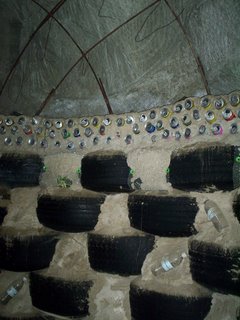 The thermal mass of tires and cement heat up from the sun's warmth and slowly release that heat into the home, which allows them to not worry about heating their home with traditional means. They are also able to have a tropical garden with bananas, avocados, peaches and pineapples all year long!
The thermal mass of tires and cement heat up from the sun's warmth and slowly release that heat into the home, which allows them to not worry about heating their home with traditional means. They are also able to have a tropical garden with bananas, avocados, peaches and pineapples all year long!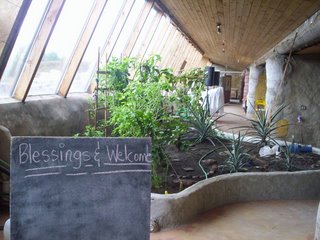 None of us at the workshop had ever seen an earthship before and it definitely was an intreguing way to start off the week. I would love to build one some day!
None of us at the workshop had ever seen an earthship before and it definitely was an intreguing way to start off the week. I would love to build one some day!
Strawbale House & Passive Solar Design: The following day we visited two more off-gride houses: Skye's strawbale house as well as the passive solar house of Frank & Cheryl on the neighboring property. Frank assisted in the design and building of Skye's house, so he showed us some slideshows of strawbale construction as well as green building design in general. Frank and Sheryl's house below generates more than enough solar power on sunny summer days for their energy needs, and their freestanding wind turbine generates power on windy days. You can see the greenhouse attached to their home, the solar generator below it (it makes sense to have a solar generator on ground level so the hot water will rise rather than having to pump it down from a generator on the roof), and the cantilever structure of the house - a passive solar design that allows the sun to heat up the bottom floor in the winter, and keep it cool in the summer.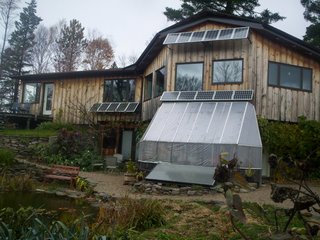
Biodiesel Steve: On Friday, Big Steve came to the Algonquin Tea Company to show us how to make biodiesel. He receives large quantities of used cooking oil from nearby restaurants and turns it into biodiesel, which individuals and companies can purchase from him. I've made biodiesel before (waaay back in Brian McAdoo's OIL class- anyone remember?) but it was fun to learn more about the process being done up in this area of Canada. The climate is a concern of course, as biodiesel and straight veggie oil tend to harden at colder temperatures. This is why most biodiesel tends to be a blend of B5 to B20, with 5 or 20% biodiesel and the rest petrolium diesel, to prevent congealing.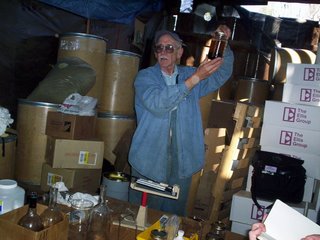 While not his specialty, Steve answered our questions about SVO (straight veggie oil) as well. Most people using SVO will set up a separate tank of petrodiesel to start the engine, and once it's warmed up, switch to SVO. This is definitely something I want to look into for a cross country trip next year!
While not his specialty, Steve answered our questions about SVO (straight veggie oil) as well. Most people using SVO will set up a separate tank of petrodiesel to start the engine, and once it's warmed up, switch to SVO. This is definitely something I want to look into for a cross country trip next year!
One of the best parts of the workshop was our lunch discussion with Steve about the problems of society and the climate of change he sees everywhere, especially in young people today. We all spoke about our feelings of connectedness with each other, the universe, god, whatever you want to call it. Discussions like this, which sprang up many times over the course of the workshop, were some of the most intense, important and introspective events during the week. I feel so thankful to have connected with everyone at the workshop, and to have had the opportunity to open up and share our thoughts, knowledge and resources in such a comfortable environment.
Foraging, Baking, Preserving: Over the weekend we went out on the Algonquin Tea Company property with Steven, who started the tea company about 10 or so years ago. He spoke about so many medicinal herbs and plants growing everywhere, some of which had been planted, some of which were growing wild.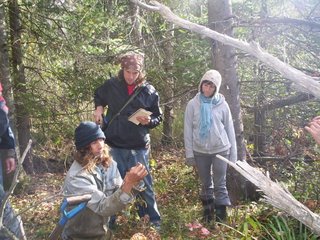 Steven's partner Megan, who had been cooking all the amazing meals for our workshop, taught us how to make sourdough bread and kefir, a live bacteria similar to yogurt or sour cream that replenishes the good bacteria in your gut. I'd definitely like to experiment with sourdough bread - anyone up for trying some?
Steven's partner Megan, who had been cooking all the amazing meals for our workshop, taught us how to make sourdough bread and kefir, a live bacteria similar to yogurt or sour cream that replenishes the good bacteria in your gut. I'd definitely like to experiment with sourdough bread - anyone up for trying some?
Steven and Megan also instructed us on preserving/canning foods and we spent an afternoon washing, coring and cutting apples and pears to can them. Somewhere along the way we had the idea of making dessert, so a yummy pear/apple crisp was born! And there was still leftover fruit to preserve some!
By Sunday afternoon we were all brimming with new information on sustainable living but knew we had to get back to the 'real world'. For me it was time to move on to my WWOOFing experience at Spring Life Farm.
~~
Thank you to all of you who who played a part in making this workshop so enjoyable - I want to continue building on this knowledge and to that effect I am excited to visit some ecovillages and take more classes on subjects of self-sufficient living. I'm not convinced yet how exactly I will make use of this knowledge, but I only know that I will.





No comments:
Post a Comment